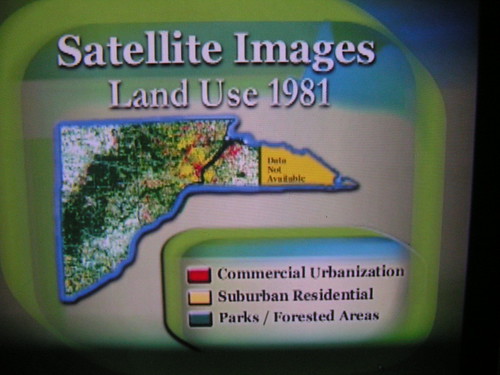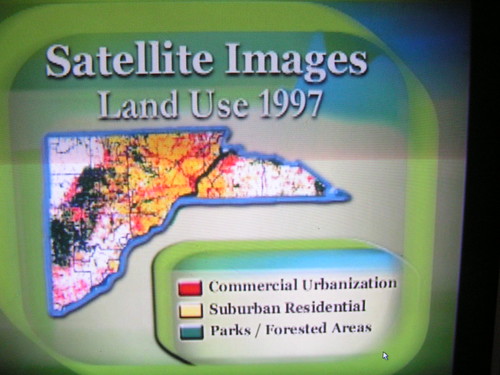You're viewing old version number 1. - Current version
Toledo area suburban sprawl
The greenspace in Lucas County is being chewed up well. Note the 16-year change between '81 and '97 in the images below. Obviously, we have less greenspace 16 years later.
The images below would make sense if our population was growing. But our county's population has declined over the past 30 to 40 years while the amount of developed land has more than doubled. I'm assuming that means a lot of vacant properties exists in Toledo.
1970 : 484,370 : 6.0%
1980 : 471,741 : −2.6%
1990 : 462,361 : −2.0%
2000 : 455,054 : −1.6%
2010 : 441,815 : −2.9%
1970 : 383,818 : 20.7%
1980 : 354,635 : −7.6%
1990 : 332,943 : −6.1%
2000 : 313,619 : −5.8%
2010 : 287,208 : −8.4%


I'm guessing that it's easier for developers to work up farmland for commercial or residential development than it is to pigeonhole a project inside Toledo.
Developing farmland outside Toledo can also mean less hassle political-wise. I understand the charm in old buildings, but whenever someone threatens to tear down an old building, outrage ensues by activists. Then Toledo has these guidelines like the 20/20 plan for how development should occur within the city. The Westgate redevelopment project butted heads with this plan.
Toledo State of the City Speech February 6, 2006
Over the last several weeks, the Old Orchard community has discussed the redevelopment of the Westgate Village Shopping Center. We want to get that development done, but we must get this project done right. Very few years ago, Toledo City Council, led by the Toledo-Lucas County Plan Commission, adopted a 20/20 plan to guide City revitalization efforts. I believe this plan can enhance our quality of life. Westgate can once again be a jewel for our community, but that won’t be achieved if our planning officials settle for minimum development standards.
That was Carty's speech. "We?" That's the problem: government involvement. That doesn't mean that the developers get to do whatever they want, but local government nearly derailed the Westgate redevelopment project by sticking their nose too deep into the plans. Costco demanded and received a waiver on Toeldo's living wage issue but that was not well-received by some officials, including Carty who threatened to veto council's waiver decision.
Whole Foods was a possible candidate to be an anchor at the new Westgate, but then the Toledo area union people protested, and then eventually Whole Foods said goodbye. I don't know if one action was based upon the other.
Comment that aggregates info from old comments from 2005 and 2006. Liz Holland's company owns the Westgate property.
-- start --
First, a little context - November 2004 - Toledo Talk thread that referenced a Columbus Dispatch article:
... Toledo, the second-most unionized city in the nation.
September 2005 - Toledo Talk - Costco versus Whole Foods that referenced a Frank Szollosi blog posting where Frank said:
Carty Finkbeiner threatens Costco and Westgate redevelopment. Carty's choice is Whole Foods, whose CEO has compared unions to herpes. Whole Foods at Westgate would threaten the good United Food and Commercial Workers at Krogers.
January 2006 - Toledo Talk - Finkbeiner vs. Holland? - my comment in that thread:
According to Liz Holland of Westgate, Whole Foods has zero interest in the Toledo area market. That means they're not interested in Toledo, Maumee, Perrysburg, nowhere around here. According to Holland, anyway.Holland said Abbell approached Whole Foods about a year ago. She told Whole Foods they were talking with Costco about coming to Westgate. At that point, Whole Foods became interested in Toledo, but for some reason, Whole Foods later lost all interest in this region.
-- end --
Toledo political factions warred over what store should anchor Westgate even though Liz Holland's company owned the property. Citizens in that area were not pleased with Holland's proposed plan even though the old Westgate was on life support from a business perspective.
Holland presented her redevelopment plan in August 2005. Local officials protested and later that year, local politicians devised their own plans for the Westgate redevelopment.
Democrat Keith Wilkowski, a former Lucas County commissioner, said the center "can do better" than a Costco. [Wilkowski] said he'd like to implement the five-year-old "Walk Westgate" plan, which sought to make the area more appealing to pedestrians. "A tremendous amount of planning has gone into developing it, not in a big-box kind of way," Mr. Wilkowski said.Mr. Finkbeiner opposes large-box retail in general and was leery of Costco because of one of its store's effects on a neighborhood in Dayton.
In the same week Mayor-elect Carty Finkbeiner blasted plans to bring a Costco to Westgate Village Shopping Center, he flipped his position. [Carty] said yesterday he now supports the $35 million project, but only if all involved agree to a visually pleasing store in a plaza with lampposts and other eye-catching amenities.
Mr. Finkbeiner stood with Lucas County Commissioners Pete Gerken and Tina Skeldon Wozniak in the shopping center to discuss their plans for it.
Along that vein, the three elected officials announced plans to spend up to $15,000 of taxpayer money through the newly reformed Lucas County Improvement Corp. to hire three urban planning "professionals," including failed mayoral candidate Keith Wilkowski, to come up with development proposals.
The urban planners would submit ideas for the best design for the flagging Westgate.
The politicians insisted the redevelopment follow the guidelines of a two-year-old plan called "Walk Westgate," which was a process to study and change zoning laws to promote pedestrian-friendly commerce.
As a developer, would you want those political dolts guiding your project?
Liz Holland led the redevelopment of Westgate. She chose to redevelop that property and not close it down and leave it empty or try to sell it or try to develop outside Toledo.
The Westfield Mall redevelopment was not led by government. I assume Toledo is making tax revenue from the new Westgate and the new Westfield Mall. But those projects are located in busy areas, and they are close to Ottawa Hills and Sylvania.
But if the barriers are lower in the soybean fields outside Toledo, then I can understand why developers start there first, instead of trying to rework existing land in Toledo and dealing with the hassles from Toledo politicians and special interest groups.
The Marina District land. That's waterfront property located downtown, and it remains undeveloped except for the road to nowhere. Why?
From a nature perspective, that scruffy Marina District property has now become good habitat for some grassland birds, such as the Eastern Meadowlark and the Savannah Sparrow. I observed those and other bird species last Saturday at the Marina District. Those birds will attempt to nest on that property. It's amazing that one can find those bird species in the downtown of a mid-sized city because those birds require plenty of open space.
Well, grassland habitat outside Toledo gets developed, so now vacant land inside the city becomes the new grassland. Unfortunately, the city will mow the Marina District land and disrupt things. Maybe it should be turned into a park.
From JR's : articles
1188 words - 7377 chars
- 6 min read
created on
updated on
- #
source
- versions